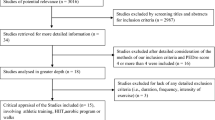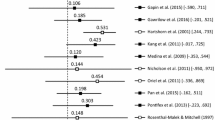Abstract
Attention deficit hyperactivity disorder (ADHD) is a frequently diagnosed neurodevelopmental disorder in children and adolescents. The objective of this review was to synthesize empirical studies that investigated the effects of physical activity (PA) on motor proficiency in this population. A systematic review and meta-analysis were conducted following the cochrane guidelines for systematic reviews. In May 2022, a systematic search of eight electronic databases retrieved 476 results, which were screened independently by two reviewers. Based on the inclusion and exclusion criteria, 12 studies were selected for systematic review, and 10 were included in the meta-analysis. A beneficial effect of PA on overall motor proficiency (SMD = 1.12; 95% CI [0.63 to 1.61]; p < 0.05) was observed. Similar positive effects were found for motor proficiency composites, including object control, fine manual control, and body coordination. These results indicate that PA improves the motor proficiency of children and adolescents with ADHD.



Similar content being viewed by others
Data Availability
All data generated or analyzed during this study were included in the article.
References
American Psychiatric Association, DSMTF (2013) Diagnostic and statistical manual of mental disorders: DSM-5, 5th edn. American Psychiatric Association, Washington
Arnold LE, Abikoff HB, Cantwell DP, Conners CK, Elliott G, Greenhill LL, Hechtman L, Hinshaw SP, Hoza B, Jensen PS, Kraemer HC, March JS, Newcorn JH, Pelham WE, Richters JE, Schiller E, Severe JB, Swanson JM, Vereen D, Wells KC (1997) National institute of mental health collaborative multimodal treatment study of children with ADHD (the MTA): design challenges and choices. Arch Gen Psychiatr 54(9):865–870. https://doi.org/10.1001/archpsyc.1997.01830210113015
Benzing V, Chang Y-K, Schmidt M (2018) Acute Physical Activity enhances executive functions in children with ADHD. Sci Rep 8(1):1–10. https://doi.org/10.1038/s41598-018-30067-8
Benzing V, Schmidt M (2019) The effect of exergaming on executive functions in children with ADHD: a randomized clinical trial. Scand J Med Sci Sports 29(8):1243–1253.
Bruininks RH, Bruininks BD (2005) Bruininks-Oseretsky Test of Motor Proficiency, Second Edition (BOT-2) [Database record]. APA PsycTests.
Caye A, Swanson JM, Coghill D, Rohde LA (2019) Treatment strategies for ADHD: an evidence-based guide to select optimal treatment. Mol Psychiatr 24(3):390–408. https://doi.org/10.1038/s41380-018-0116-3
Chang Y-K, Hung C-L, Huang C-J, Hatfield BD, Hung T-M (2014) Effects of an aquatic Exercise program on inhibitory control in children with ADHD: a preliminary study. Arch Clin Neuropsych 29(3):217–223. https://doi.org/10.1093/arclin/acu003
Cheung KKW, Wong ICK, Ip P, Chan PKL, Lin CHY, Wong LYL, Chan EW (2015) Experiences of adolescents and young adults with ADHD in Hong Kong: treatment services and clinical management. BMC Psychiatr 15(1):95–95. https://doi.org/10.1186/s12888-015-0478-x
Egger M, Smith GD, Schneider M, Minder C (1997) Bias in meta-analysis detected by a simple, graphical test. BMJ 315(7109):629–634. https://doi.org/10.1136/bmj.315.7109.629
Gallotta MC, Baldari C, Guidetti L (2018) Motor proficiency and physical activity in preschool girls: a preliminary study. Early Child Develop Care 188(10):1381–1391. https://doi.org/10.1080/03004430.2016.1261337
Gaya A, Silva G (2006) Manual de aplicação de medidas e testes, normas e critérios de avaliação. Projeto Esporte Brasil, 1–27.
Golubovic S, Milutinovic D, Golubovic B (2014) Benefits of physical exercises in developing certain fitness levels in children with hyperactivity. J Psychiatr Ment Health Nurs 21(7):594–600. https://doi.org/10.1111/jpm.12091
Goulardins JB, Rigoli D, Piek JP, Kane R, Palácio SG, Casella EB, Nascimento RO, Hasue RH, Oliveira JA (2016) The relationship between motor skills, ADHD symptoms, and childhood body weight. Res Dev Disabil 55:279–286. https://doi.org/10.1016/j.ridd.2016.05.005
Goulardins JB, Marques JCB, De Oliveira JA (2017) Attention deficit hyperactivity disorder and motor impairment: a critical review. Percept Mot Skills 124(2):425–440. https://doi.org/10.1177/0031512517690607
Hartung J, Knapp G, Sinha BK (2008) Statistical meta-analysis with applications. Wiley, Hoboken
Higgins JPT, Green S (2011) Cochrane Handbook for systematic reviews of interventions. Wiley, Hoboken
Huang WY, Wong SHS, Sit CHP, Wong MCS, Sum RKW, Wong SWS, Yu JJ (2018) Results from Hong Kong’s 2018 report card on physical activity for children and youth. J Phys Act Health 15(2):S370–S372. https://doi.org/10.1123/JPAH.2018-0468
Iivonen KS, Sääkslahti AK, Mehtälä A, Villberg JJ, Tammelin TH, Kulmala JS, Poskiparta M (2013) Relationship between fundamental motor skills and physical activity in 4-year-old preschool children. Percept Mot Skills 117(2):627–646. https://doi.org/10.2466/10.06.PMS.117x22z7
Jeyanthi S, Arumugam N, Parasher RK (2019) Effect of physical exercises on attention, motor skill and physical fitness in children with attention deficit hyperactivity disorder: a systematic review. ADHD Atten Deficit Hyperact Disord 11(2):125–137. https://doi.org/10.1007/s12402-018-0270-0
Jeyanthi S, Arumugam N, Parasher RK (2021) Effectiveness of structured exercises on motor skills, physical fitness and attention in children with ADHD compared to typically developing children: a pilot study. eNeurologicalSci 24:100357–100357. https://doi.org/10.1016/j.ensci.2021.100357
Jones D, Innerd A, Giles EL, Azevedo LB (2020) Association between fundamental motor skills and physical activity in the early years: a systematic review and meta-analysis. J sport health Sci 9(6):542–552. https://doi.org/10.1016/j.jshs.2020.03.001
Kaiser ML, Schoemaker MM, Albaret JM, Geuze RH (2015) What is the evidence of impaired motor skills and motor control among children with attention deficit hyperactivity disorder (ADHD)? systematic review of the literature. Res Dev Disabil 36:338–357. https://doi.org/10.1016/j.ridd.2014.09.023
Landry BW, Driscoll SW (2012) Physical activity in children and adolescents. PM&R 4(11):826–832. https://doi.org/10.1016/j.pmrj.2012.09.585
Leahy LG (2018) Diagnosis and treatment of ADHD in children vs adults: what nurses should know. Arch Psychiatr Nurs 32(6):890–895. https://doi.org/10.1016/j.apnu.2018.06.013
Liang X, Li R, Wong SHS, Sum RKW, Sit CHP (2021) The impact of exercise interventions concerning executive functions of children and adolescents with attention-deficit/hyperactive disorder: a systematic review and meta-analysis. Int J Behav Nutr Phys Act 18(1):68–68. https://doi.org/10.1186/s12966-021-01135-6
Maher CG, Sherrington C, Herbert RD, Moseley AM, Elkins M (2003) Reliability of the PEDro Scale for rating quality of randomized controlled trials. Phys Ther 83(8):713–721. https://doi.org/10.1093/ptj/83.8.713
Meßler CF, Holmberg H-C, Sperlich B (2018) multimodal therapy involving high-intensity interval training improves the physical fitness, motor skills, social behavior, and quality of life of boys with ADHD: a randomized controlled study. J Atten Disord 22(8):806–812. https://doi.org/10.1177/1087054716636936
Mercurio LY, Amanullah S, Gill N, Gjelsvik A (2021) Children with ADHD engage in less physical activity. J Atten Disord 25(8):1187–1195. https://doi.org/10.1177/1087054719887789
O’Connor BC, Fabiano GA, Waschbusch DA, Belin PJ, Gnagy EM, Pelham WE, Greiner AR, Roemmich JN (2014) Effects of a summer treatment program on functional sports outcomes in young children with ADHD. J Abnorm Child Psychol 42(6):1005–1017. https://doi.org/10.1007/s10802-013-9830-0
Orangi BM, Rasoul Y, Behrouz G, Paul L, Amin A (2021) The Effect of Aerobic Exercise with nonlinear pedagogy on anxiety, depression, motor proficiency and cognitive ability of boys with attention deficit hyperactivity disorder. J Rehabilit Sci Res 8(3):144–150. https://doi.org/10.30476/jrsr.2021.91068.1163
Page MJ, McKenzie JE, Bossuyt PM, Boutron I, Hoffmann TC, Mulrow CD, Shamseer L, Tetzlaff JM, Akl EA, Brennan SE, Chou R, Glanville J, Grimshaw JM, Hróbjartsson A, Lalu MM, Li T, Loder EW, Mayo-Wilson E, McDonald S, McGuinness LA, Stewart LA, Thomas J, Tricco AC, Welch VA, Whiting P, Moher D (2021) The PRISMA 2020 statement: an updated guideline for reporting systematic reviews. BMJ 372:n71. https://doi.org/10.1136/bmj.n71
Pan C-Y, Chang Y-K, Tsai C-L, Chu C-H, Cheng Y-W, Sung M-C (2017a) Effects of physical activity intervention on motor proficiency and physical fitness in children with ADHD: an exploratory study. J Atten Disord 21(9):783–795. https://doi.org/10.1177/1087054714533192
Pan C-Y, Chu C-H, Tsai C-L, Sung M-C, Huang C-Y, Ma W-Y (2017b) The impacts of physical activity intervention on physical and cognitive outcomes in children with autism spectrum disorder. Autism 21(2):190–202. https://doi.org/10.1177/1362361316633562
Pan C-Y, Tsai C-L, Chu C-H, Sung M-C, Huang C-Y, Ma W-Y (2019) Effects of physical exercise intervention on motor skills and executive functions in children with ADHD: a pilot study. J Atten Disord 23(4):384–397. https://doi.org/10.1177/1087054715569282
Papadopoulos N, Rinehart NJ, Bradshaw JL, Taffe J, McGinley J (2015) Is there a link between motor performance variability and social-communicative impairment in children with ADHD-CT: a kinematic study using an Upper Limb Fitts’ Aiming Task. J Atten Disord 19(1):72–77. https://doi.org/10.1177/1087054712454569
Rigoli D, Piek JP, Kane R, Oosterlaan J (2012) An examination of the relationship between motor coordination and executive functions in adolescents. Dev Med Child Neurol 54(11):1025–1031. https://doi.org/10.1111/j.1469-8749.2012.04403.x
Rigoli D, Kane RT, Mancini V, Thornton A, Licari M, Hands B, McIntyre F, Piek J (2017) The relationship between motor proficiency and mental health outcomes in young adults: a test of the environmental stress hypothesis. Hum Mov Sci 53:16–23. https://doi.org/10.1016/j.humov.2016.09.004
Rowland AS, Skipper BJ, Umbach DM, Rabiner DL, Campbell RA, Naftel AJ, Sandler DP (2015) The prevalence of ADHD in a population-based sample. J Atten Disord 19(9):741–754. https://doi.org/10.1177/1087054713513799
Schatz NK, Fabiano GA, Cunningham CE, dosReis S, Waschbusch DA, Jerome S, Lupas K, Morris KL (2015) Systematic review of patients’ and parents’ preferences for ADHD treatment options and processes of care. Patient-Patient-Cent Outcomes Res 8(6):483–497. https://doi.org/10.1007/s40271-015-0112-5
Sherrington C, Moseley AM, Herbert RD, Elkins MR, Maher CG (2010) Ten years of evidence to guide physiotherapy interventions: physiotherapy evidence database (PEDro). Br J Sports Med 44(12):836–837. https://doi.org/10.1136/bjsm.2009.066357
Silva LAD, Doyenart R, Henrique Salvan P, Rodrigues W, Lopes JF, Gomes K, Thirupathi A, Pinho RAD, Silveira PC (2019) Swimming training improves mental health parameters, cognition and motor coordination in children with attention deficit hyperactivity disorder. Int J Environ Health Res. https://doi.org/10.1080/09603123.2019.1612041
Sprich SE, Safren SA, Finkelstein D, Remmert JE, Hammerness P (2016) A randomized controlled trial of cognitive behavioral therapy for ADHD in medication-treated adolescents. J Child Psychol Psychiatr 57(11):1218–1226. https://doi.org/10.1111/jcpp.12549
Stodden DF, Goodway JD, Langendorfer SJ, Roberton MA, Rudisill ME, Garcia C, Garcia LE (2008) A developmental perspective on the role of motor skill competence in physical activity: an emergent relationship. Quest 60(2):290–306. https://doi.org/10.1080/00336297.2008.10483582
Torabi F, Farahani A, Safakish S, Ramezankhani A, Dehghan F (2018) Evaluation of motor proficiency and adiponectin in adolescent students with attention deficit hyperactivity disorder after high-intensity intermittent training. Psychiatr Res 261:40–44. https://doi.org/10.1016/j.psychres.2017.12.053
Verret C, Guay M-C, Berthiaume C, Gardiner P, Béliveau L (2012) A physical activity program improves behavior and cognitive functions in children with ADHD: an exploratory study. J Atten Disord 16(1):71–80. https://doi.org/10.1177/1087054710379735
Vysniauske R, Verburgh L, Oosterlaan J, Molendijk ML (2020) The effects of physical exercise on functional outcomes in the treatment of ADHD: a Meta-analysis. J Atten Disord 24(5):644–654. https://doi.org/10.1177/1087054715627489
Welsch L, Alliott O, Kelly P, Fawkner S, Booth J, Niven A (2021) The effect of physical activity interventions on executive functions in children with ADHD: a systematic review and meta-analysis. Ment Health Phys Act 20:100379. https://doi.org/10.1016/j.mhpa.2020.100379
Wiggins LD, Rice CE, Barger B, Soke GN, Lee L-C, Moody E, Edmondson-Pretzel R, Levy SE (2019) DSM-5 criteria for autism spectrum disorder maximizes diagnostic sensitivity and specificity in preschool children. Soc Psychiatr Psychiatr Epidemiol 54(6):693–701. https://doi.org/10.1007/s00127-019-01674-1
Yazd SNT, Ayatizadeh F, Dehghan F, Machado S, Wegner M (2015) Comparing the Effects of Drug Therapy, Perceptual Motor Training, and both combined on the Motor Skills of School-Aged attention deficit hyperactivity disorder children. CNS Neurol Disord-Dr 14(10):1283–1291. https://doi.org/10.2174/1871527315666151111123501
Ziereis S, Jansen P (2015) Effects of physical activity on executive function and motor performance in children with ADHD. Res Dev Disabil 38:181–191. https://doi.org/10.1016/j.ridd.2014.12.005
Funding
Venus H.L. Liu, F.H. Sun, Andy C.Y. Tse, and David I. Anderson declare that they received no funding for the study.
Author information
Authors and Affiliations
Contributions
VHLL and ACYT were responsible for conceptualizing the review, delimiting the scope of the search, and formulating hypotheses. Venus VHLL and FHS conducted the systematic search, data extraction, assessment of risk of bias and completed all statistical analyses. FHS, ACYT, and DIA reviewed and edited the initial draft of the manuscript and its revisions. All authors read and approved the final manuscript.
Corresponding author
Ethics declarations
Competing interest
Venus H.L. Liu, F.H. Sun, Andy C.Y. Tse, and David I. Anderson declare that they have no conflict of interest.
Ethical Approval
Not applicable as the study was conducted with the secondary data.
Additional information
Publisher’s Note
Springer Nature remains neutral with regard to jurisdictional claims in published maps and institutional affiliations.
Rights and permissions
Springer Nature or its licensor (e.g. a society or other partner) holds exclusive rights to this article under a publishing agreement with the author(s) or other rightsholder(s); author self-archiving of the accepted manuscript version of this article is solely governed by the terms of such publishing agreement and applicable law.
About this article
Cite this article
Liu, H.L.V., Sun, F., Anderson, D.I. et al. The Effect of Physical Activity Intervention on Motor Proficiency in Children and Adolescents with ADHD: A Systematic Review and Meta-analysis. Child Psychiatry Hum Dev (2023). https://doi.org/10.1007/s10578-023-01546-5
Accepted:
Published:
DOI: https://doi.org/10.1007/s10578-023-01546-5




